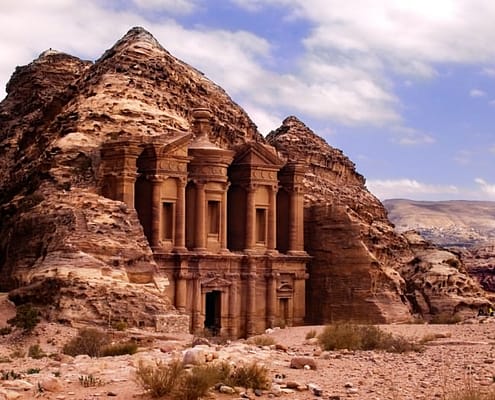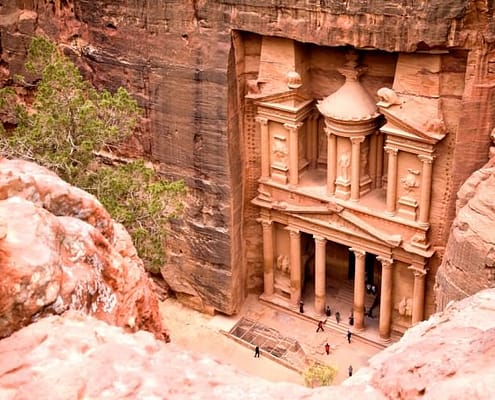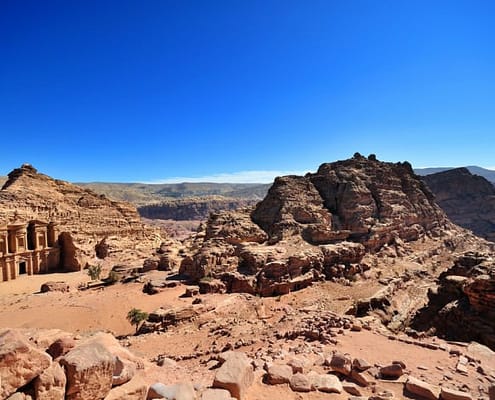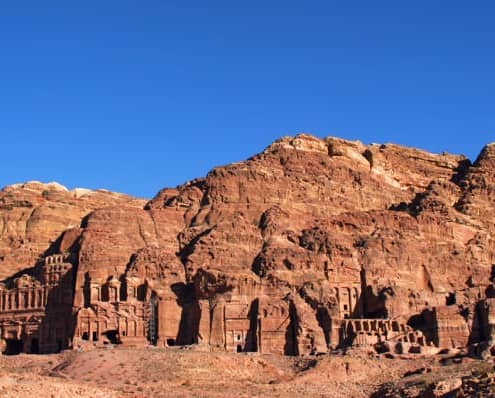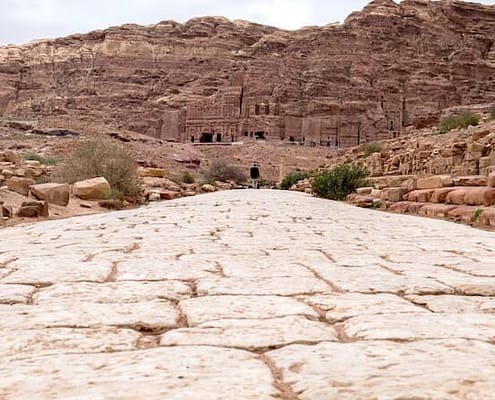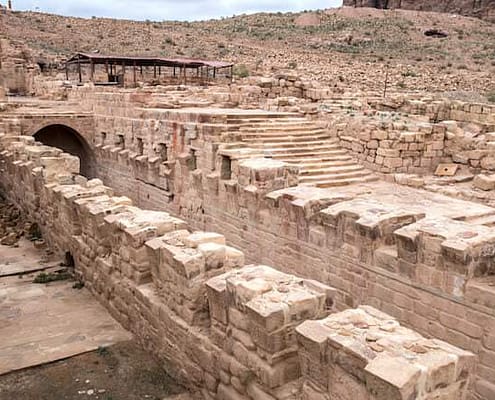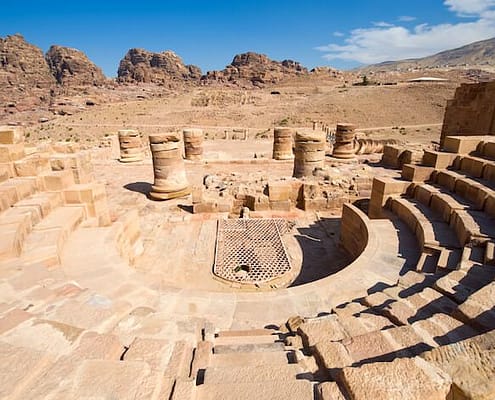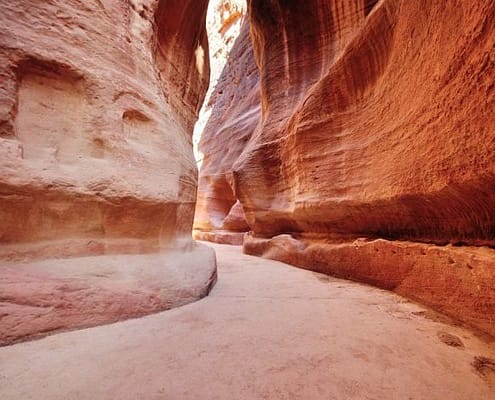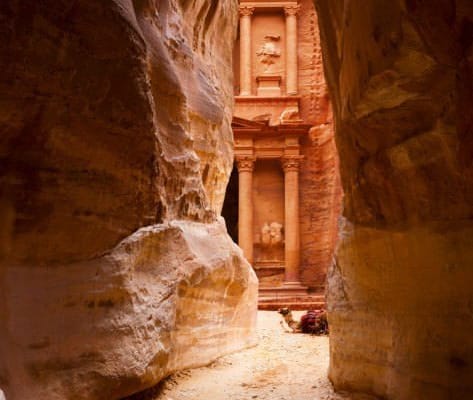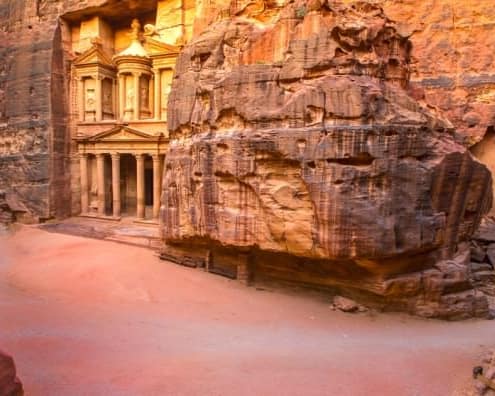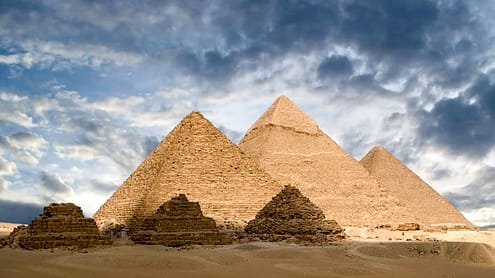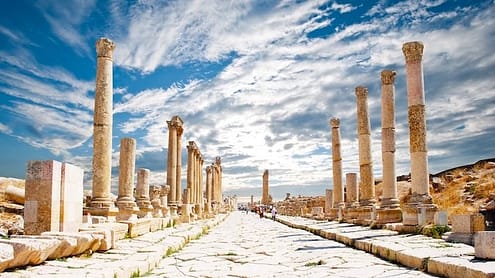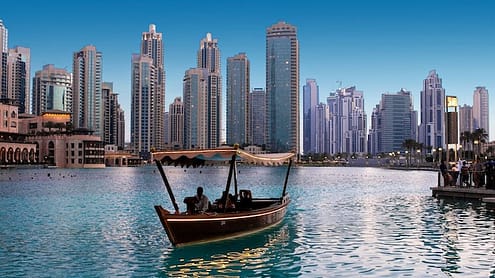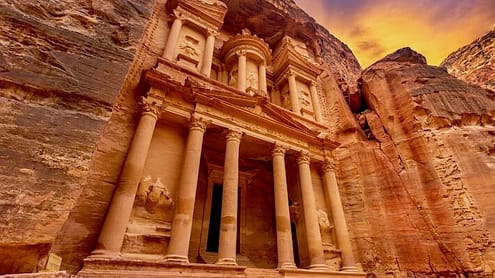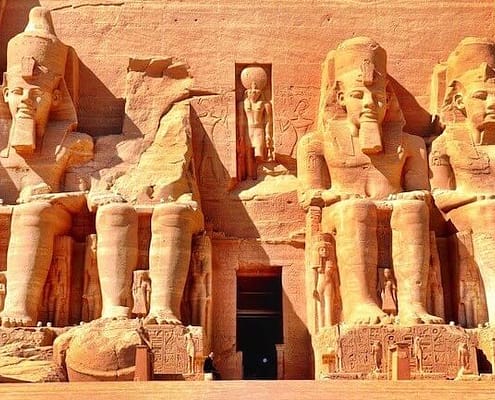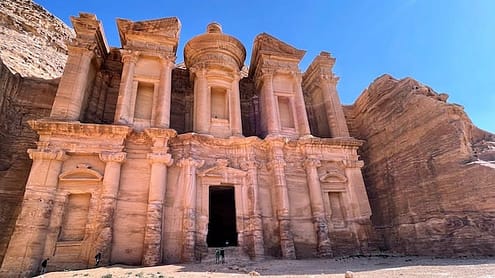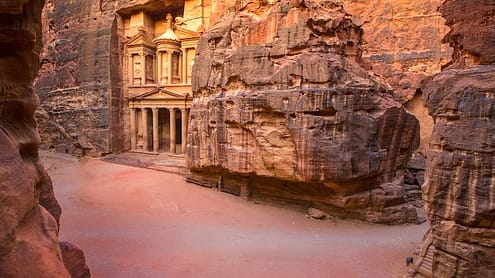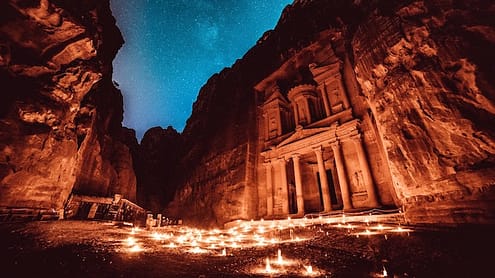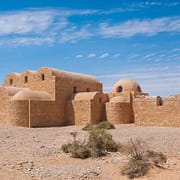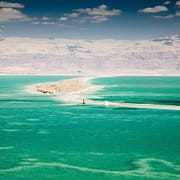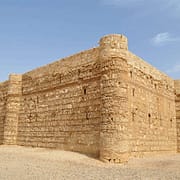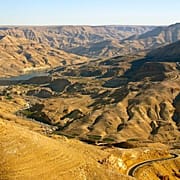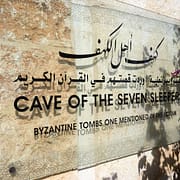Rose City Of Petra – A Striking Prehistoric Rock Carved City
Petra, or the Rose City of Petra as it is often called, is an ancient rock-carved Nabataean city located in Jordan between the Dead Sea and Red Sea, in the country’s Ma’an governorate. Such is the historical value of the site, that in 1985 it was officially declared a UNESCO World Heritage Site. Because we believe that no visit to Jordan is complete without a visit to Petra, you will find it featured in nearly all of our Egypt and Jordan tours.

The Treasury of the Rose City of Petra, Jordan.
There is some uncertainty as to the exact age of the Rose City of Petra although most historians believe the city was established around 312 BCE or perhaps even earlier. Interestingly, it remained hidden from the Western world until it was discovered by an explorer who had made his way to Jordan in 1812. In his diary he wrote that he had found a “Rose Red City half as old as time”, and anyone who has visited the site will surely agree.
The Rose City of Petra has also been called a Nabataean “caravan-city” because it served as an important trading hub for Arabian incense traders; Chinese silk traders and Indian spice traders. The city is half carved and half built, and it is today considered to be one of the most valuable archaeological sites in the world.
Inside The Rose City Of Petra
The Rose City or Rose Red City of Petra gets its name from the color of the rock into which it’s been carved. The city is also famous for its ingenious water management system which effectively allowed its inhabitants to live all year round in what would otherwise have been a very inhospitable area. A complex network of cisterns; reservoirs and an extensive conduit system made it possible to not only collect seasonal rainwater, but also to distribute that water throughout the city.
Because the city has been inhabited by the Nabataeans, the Romans and the Greeks during the course of history, the interior and exterior architecture is a classic blend of styles representative of the different eras and cultures.
Visitors can spend an entire day or even longer at the Rose City of Petra exploring the many rooms; chambers; catacombs; tombs and temples which make up this fascinating city. There really is so much to see, and many tourists end up returning to the site several times.
Most of Petra tours last for approximately two hours. However, all of our Egypt and Jordan tours can be customized for those people who would like to spend more time exploring this magnificent site.
Al Khazneh – The Treasury

Facade of the Treasury (Al Khazneh) in Petra.
Al-Khazneh in Petra, which is also routinely referred to as the Treasury, is the most visited of all the various Petra tourist attractions. Like nearly all the other monumental building in the ancient city of Petra, Al-Khazneh was carved out of a sandstone rock face during the 1st century AD.
It is generally believed that Al-Khazneh was built to serve as the mausoleum of the Nabatean king, Aretas IV, but there is no definitive proof of this. Whatever its original purpose was, Al-Khazneh is by far the most magnificent out of the 800 or more monuments at Petra. Not only is it the top attraction at Petra, but it is also the best ancient monument in all of Jordan. Especially by night.

The Treasury in Petra by night.
At one point in history, it was believed that pirates and thieves hid their treasures inside the giant ornate urn which can be seen on the second floor inside Al-Khazneh. This is probably how it became known as the Treasury. The urn has in fact been badly defaced as a result of being shot at. Not knowing that it was a solid piece of rock, local Bedouins used to shoot at it in the hope that it would crack open and reveal hidden treasure.
In order to reach this magnificent monument, visitors have to follow a 1.5 km-long path. It is only when you reach the end of the path that Al-Khazneh finally reveals itself. This must surely be one of the most rewarding walks imaginable, and one which no tourist will ever forget. There are many amazing Jordan tourist attractions, but Petra certainly tops the list.
Ad Deir – The Monastery

Stunning view of Ad Deir – AKA the Monastery.
Ad Deir is one of the most visited Petra tourist attractions. It is also one of the biggest monumental buildings in the ancient city of Petra, measuring 50 meters in width (160 ft) and 45 meters in height (148 ft). As with all the other building at this site, Ad Deir was carved out of the mountain.
While it is often called the Monastery, it is worth noting that it was never a monastery. Instead, it was a temple that was dedicated to King Obodas I, a Nabatean king who reigned over Petra during the 1st century BCE.
The temple’s interior is very basic, in that it only has a huge single chamber with some stairs leading up to a niche which would no doubt have served as an altar. There are also two Christian crosses carved out of the interior walls, but this was done at a much later date, suggesting that the building might have been inhabited by a few monks at some point.
There are also some nearby carvings, as well as a very interest cave. In the past, visitors were also allowed to climb the mountain behind Ad Deir so that they could sit on the large rim at the base of the urn. However, for safety reasons, as well as preservation reasons, this is no longer allowed.
Hiking up to Ad Deir from the city of Petra is not really much of a challenge, but it does involve quite a bit of walking that includes have to climb about 800 stairs along the way. It is usually also possible to make the trip on a horse or donkey. As is to be expected, the hooves of these animals chip away at the hand-carved sandstone stairs, so if at all possible, visitors should always opt for walking instead.
The Great Temple of Petra
The Great Temple of Petra is one of the major components of what was once central Petra, the ancient capital of the Nabatean kingdom. It is also one of the largest structures to have been discovered at this incredible site. It was discovered by some archeologists from Brown University in 1992. Excavation work got underway almost immediately, and it continues to this day.
The Great Temple, like nearly all other structures at Petra, was built during the 1st century BC, a time when the Nabatean kingdom was flourishing, both politically and financially. The exact date of its construction remains unclear. However, archeologists at the site have found various artifacts which suggest it was built at some point towards the end of the 1st century BC, and they believe it was then extended during the 1st century AD.
As with other Nabatean temples which have been discovered, the Great Temple was a two-level complex. Due to its design and layout, it is generally accepted that the complex was indeed a temple, but no definitive proof of this has found thus far. In fact, a few artifacts have also been found which have led some to speculate that the Great Temple might actually have been a vast palace and assembly hall. At the very least, this possibility cannot be ruled out completely. Interestingly, the complex remained in use all the way up until the 5th century which was the Byzantine era.
Covering a total area of around 7,560 square meters, and having an average height of about 19 meters, the Great Temple is by far the biggest freestanding structure at the Petra site. The magnificent design and style of the Great Temple, along with its immense size, has resulted in this structure becoming one of the top Petra tourist attractions.
The Great Temple has proven to be an epic discovery, and one which has kept archeologists busy for nearly three decades already. It is fair to say that no trip to Petra is complete without a visit to the Great Temple.
Temple of Dushares in Petra

Temple of Dushares in Petra.
The Temple of Dushares, also known as Qasr el-Bint, is one of the largest free-standing structures at Petra. It also has the largest façade of all the temples at Petra. Its façade is 4 meters wider than the façade at the Great Temple, and also 4 meters wider than the façade at Al-Khazneh (The Treasury).
Unlike at many of the other Petra tourist attractions, visitors are not allowed to enter the ruins of the Temple of Dushares. The structure is fenced off, but visitors can still get close enough to be able to appreciate the magic of this incredible monument.
While not much is actually known about the early history of the Temple of Dushares, it is known that this must have been a very costly project at the time of its construction. One very clear indication of this can be seen in the temple’s central inter-axial column spacing. At the Temple of Dushares this is 8 meters, whereas at the Temple of Hercules in Amman this spacing is only 5.2 meters, and at the Temple of Artemis at Jerash it is only 4.9 meters.
Also, the individual column drums at the Temple of Dushares must have weighed at least 7 tons each. The presence and the choice of masonry, along with the high level of craftsmanship, also suggest that this temple must have been a very costly one to build. Another interesting feature at this site is the large altar to the front of the entrance. This suggests that in the case of Dushares Temple, offerings would have been made outside rather than inside, as was usually the case.
Despite only being ruins, and despite the fact that it is fenced off, the Temple of Dushares is still a wonderful monument to visit. It is also conveniently located just a minute or two away from the stairs that lead to the Monastery (Ad Deir) which is Petra’s second-most visited attraction. If you are going to be visiting the Monastery, then it would be a real shame if you pass on the opportunity to visit the Temple of Dushares as well.
The Petra Amphitheater
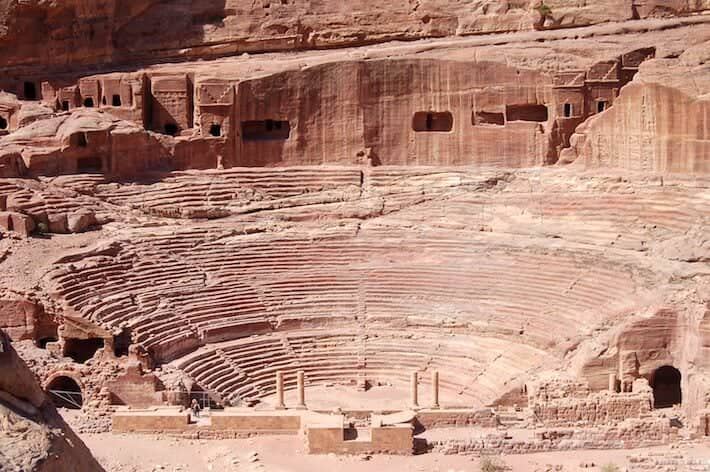
The Amphitheater in Petra.
The Petra Amphitheater is without question one of the most impressive Petra tourist attractions within the ancient Nabatean city. While the general appearance of this magnificent amphitheater certainly resembles Roman amphitheaters, there is one very significant difference. Roman theaters were constructed, whereas the Petra Amphitheater was largely carved out of rock in true Nabatean fashion.
The Petra Amphitheater was built during the reign of the Nabatean king, Aretas IV who ruled the Nabatean kingdom from 9 BC to 40 AD. During this time, several major projects were undertaken, not only at Petra, but also at other important Nabatean trading cities. This was essentially the time when the Nabatean kingdom was at its peak, culturally, politically, and financially.
The amphitheater at Petra would have be able to accommodate as many as 8,500 people, which is notably more than the famous Roman theater in Amman. The amphitheater which can be seen today is slightly different to the original design because the son of King Aretas is known to have had a few minor alterations done.
Also, after the Romans annexed the area, they had a few changes made, and they also rebuilt the theater’s exterior wall. The original design also featured a stone-built stage backdrop but this was destroyed by the major 363 AD earthquake.
The Petra Amphitheater is located roughly 600 meters from what is deemed to be the center of Petra, and in very close proximity to the Street of Facades which is another major attraction at the Petra site. The rock face which forms the back wall of the theater was once also a street of facades, but these were all destroyed in order to make way for the amphitheater. All that remains of those facades, are a few holes which are essentially the interiors of what were once tombs. One thing is for certain: a visit to the Petra Amphitheater is a visit you will never forget.
The Siq – The Grand Entrance of Petra
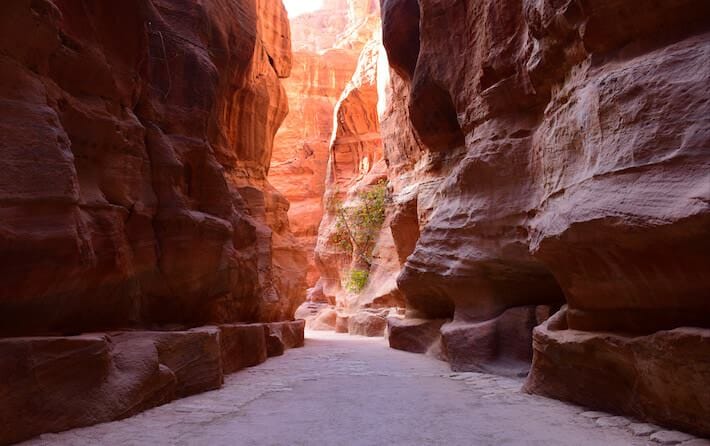
The Siq in Petra.
The Siq in Petra is a dramatic natural gorge which serves as the main entrance to the ancient Nabatean city of Petra in southern Jordan. Everyone who visits Petra has to pass through this gorge in order to access the ancient city. The Siq winds its way between the sheer rock faces on either side for a distance of about 1.2 kilometers, finally ending in front of the indescribable Al Khazneh monument. Al Khazneh is also often referred to as The Treasury, and it is the most visited of all Petra tourist attractions.
Unlike many gorges and canyons which are formed by flowing water, the Siq is a natural canyon which was formed due to the shifting of tectonic plates. The entire length of the Siq is relatively narrow, with some parts being no wider than 3 meters. The rock cliffs on either side of the path vary in height, from around 91 meters in some areas, to as much as 182 meters in other places.
The dam which can be seen at the entrance to the Siq was reconstructed in 1963 and again in 1991. The dam essentially prevents the waters of Wadi Musa from entering the Siq by redirecting its flow elsewhere. Interestingly, the Nabateans controlled the waters of Wadi Musa in much the same way.
The Siq was predominantly used as a grand entrance for arriving traders and their caravans. However, there are numerous votive niches along both walls of the Siq which suggest that the Nabateans also saw the Siq as being a sacred place. A number of underground chambers have also been discovered in the Siq, but their actual purpose remains a mystery, at least for the time being.
While it is often possible to make the journey through the Siq on horseback or on the back of a donkey, there is no denying the fact that it is far more rewarding if you do it on foot.
Touring The Ancient City Of Petra
There are two entrances to the Rose City of Petra but most tourists will simply use the entrance that is closest to the point of arrival at the site. To really appreciate the Red City of Petra, it is without a doubt best to explore the site in the company of a guide. However, some local guides might be very friendly and have nothing but the best intentions, but that doesn’t necessarily mean they are well and truly knowledgeable regarding the city’s ancient history.
The overwhelming majority of tourists explore the city on foot, but it is possible to hire a camel or a donkey from a local guide. This could be an option for people with limited mobility, or if you simply feel like doing things in a “traditional” sort of way.
Visiting Petra From Egypt
Although the Rose City of Petra is in Jordan rather than in Egypt, it has grown to be a very popular attraction among tourists traveling to Egypt. A number of tour operators now offer one day tours to Petra as well custom Egypt tours that can include any number of days in Jordan, based on your requirements.
Alternatively, our combined Egypt and Jordan Tours are a great choice. These are also very popular because you get to see the very best of Egypt as well as some of the best and most fascinating attractions in Jordan, including the Rose City of Petra.
Last Updated on January 24, 2024

